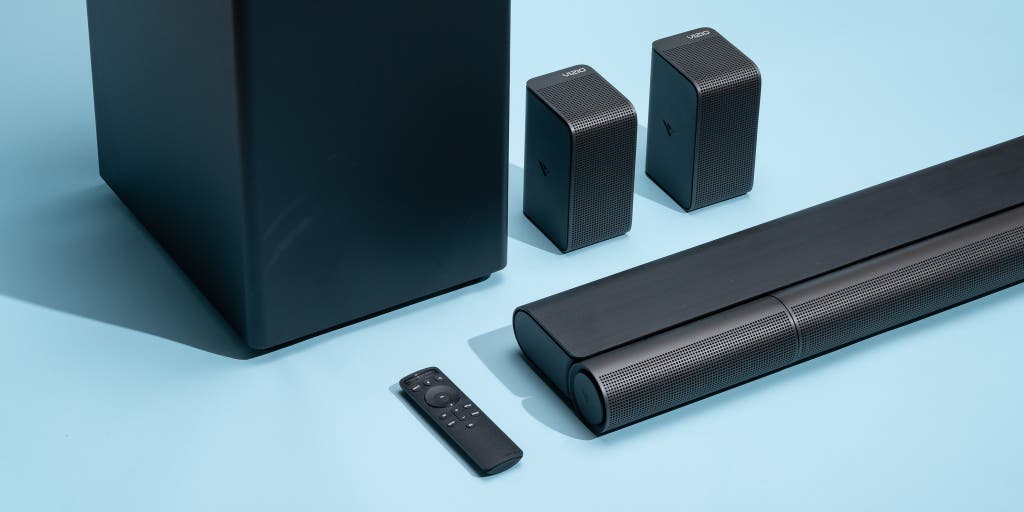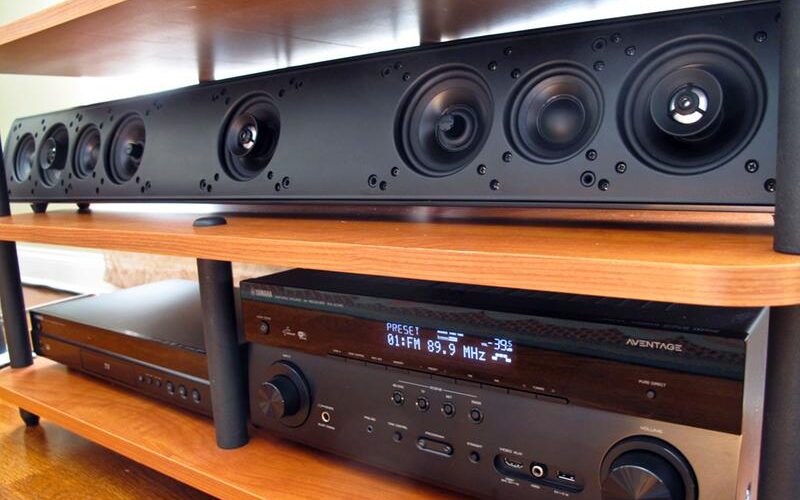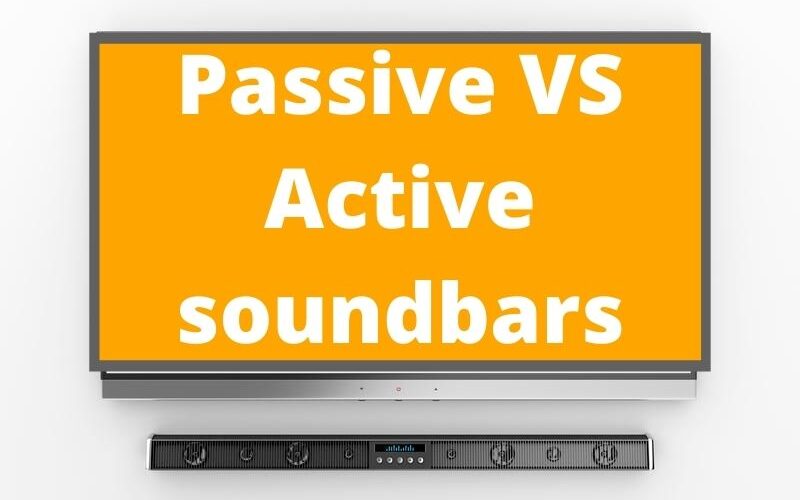Soundbars are a great way to improve sound quality in a home entertainment setup considering how slim TVs have become, especially OLED TVs. With a soundbar, you can take your setup to the next level by greatly improving your listening experience whenever you are watching a movie or listening to your favorite track.
But when most people are talking about soundbars, two main options pop up;
- Active soundbars
- Passive soundbars
Both of these soundbars are great additions for improving the sonic experience in a media room or a home theater but there are key differences between them.
Active soundbars are all-in-one sound systems with built-in amplifiers, source inputs, digital signal processors (onboard DSP), and speaker drivers. Meanwhile, Passive soundbars have no internal amplification, source inputs, or sound processors but usually, have larger speaker drivers. You need a receiver, an integrated amp, or a preamp and power amp to use a passive soundbar.
From this alone it may seem like an active soundbar is the clear winner but that may not necessarily be the case. Both options have a host of advantages and disadvantages over the other and depending on your needs and budget, you may find a passive soundbar to be way better for you.
So, before you decide, let us look at each option in more detail.
What is an active soundbar?
Most soundbars on the market today are active soundbars and the simple reason for this is convenience.
As we have seen, active soundbars have sound processors, amplification, crossovers, speaker wiring, and other components such as Bluetooth receivers and RF transmitters all integrated into one system. All these components are designed and tailored to work together.
This makes for a lightweight and is easy to install sound setup convenient for most homes and small home theater builds.
An active soundbar is what you should invest in if you do not want to go through the hassle of wiring your system which I go through in more detail here. You will only need to connect your source to the soundbar, plug it into a power outlet and place it in a great position and you are great to go.
Some active soundbars may also come with built-in software for calibration and room correction that can be done using an app on your phone and a calibration mic that comes as a bundle.
The number of channels can also vary ranging from 3.1 to 5.1 for a full surround sound experience.
Surround sound can be achieved virtually with built-in speaker drivers that are angled in different directions to give the illusion of sound coming from all directions around you or through the addition of satellite speakers to complete the surround setup. This is not forgetting that some also have up-firing speakers for 3D surround sound formats such as DTS-X and Dolby Atmos.
All this is done without needing a receiver, a preamp + power amp, or an integrated amplifier. You also don’t have to worry about component matching, especially the amp’s impedance since everything is optimized to work together with great precision.

Active soundbar signal path:
There are two main ways an active soundbar can be connected to a source and this can be through an HDMI connection or using an optical cable.
Once the soundbar is connected to the source, the audio signals are sent to the onboard processor where they are decoded and then sent to the crossover on the soundbar. The crossover filters the different signals and the high frequencies are sent to the tweeters, and mids and lows are sent to the woofers (some of the lower frequency signals may be sent to a sub if you have one).
But before the tweeters and woofers can reproduce the audio, the signals need to be amplified and this is where the built-in power amp comes in to amplify the electric signals and power the soundbar drivers for each frequency band.
The pros and cons of an active soundbar
Pros:
1. Fast and easy installation
Installing an active soundbar is quite easy as all you need to do is connect it to an audio source and a power source.
This can be done by anyone even for a first-time setup making it very convenient. You do need any professional help or technical experience to connect the cables and power cord.
Calibration is also easy on active soundbars with automatic EQ software that do room correction for you with ease without needing any more manual input from you.
2. No component matching is required
Because the internal components and speakers are designed to work together, you should not worry about matching the external components.
The drivers have all the power they need which means their performance is optimized. You do not have to worry about overdriving and blowing the speakers.
Performance is optimized further as the audio signals pass through an active crossover before being sent to the individual power amps for each driver. Each driver, therefore, gets more power because they are driven separately reducing phase shift distortion since the amplified signals hit the drivers at the same time.
3. Easy Wireless applications
Some active soundbars have transmitters and receivers that allow for easy wireless connection. These receivers and transmitters can use Bluetooth, Wi-Fi, or other radio wave technologies for wireless connections whether it is using your phone as the source using Bluetooth or Wi-Fi to send signals to speakers in other rooms (multi-room setup) or surrounds.
However, this does not mean that you will go fully wireless since the soundbar has to be connected to a power source.
4. Less interference
Home entertainment systems are prone to electromagnetic interference which causes hum and buzz in speakers.
Cables are a cause of interference in most setups. But because active soundbars have less wiring as the drivers and amps are close to each other, interference is less common.
The interference can be reduced further if the soundbar has an advanced DSP that allows for auto-calibration and compensation of any signal quality reduction that may be caused by any interference.
Cons:
1. The setup is permanent
Unless you buy a new system, you are stuck with what you purchase. You cannot tweak or make any changes to the amplification or the sound processor.
There is also less flexibility since you are stuck with the number of inputs on the soundbar. Most active soundbars have a limited number of inputs with most of them having 2 HDMI ports at most and one optical port.
2. Active soundbars are heavier
Since all components have to be crammed in the soundbar’s cabinet, the active soundbar will be heavier when compared to a passive soundbar.
What is a passive soundbar?
A passive soundbar is different from an active soundbar in that it does not have any internal amplification or DSP. You will need an external receiver, integrated amp, or a separate preamp/power amp combination just as you would do with a traditional speaker setup.
This soundbar is usually made up of speaker inputs, a passive crossover, and about 7 speaker drivers (which can vary depending on the model). These drivers include 4 woofers, 2 for the center channel, and one each for the left and right channels. There are also 3 tweeters for the center, left, and right channels for a total of 3 channels.
However, these speaker drivers are usually larger (some active soundbars have large drivers too), draw more power, and, therefore, push more air for higher sound pressure (are louder). This is why they use external amplification.
But it is worth noting that the sound quality will only be as good as all the other components in the chain and is not limited to the amplification power alone. Choosing them correctly is of the utmost importance.

It is paired with a receiver that drives it.
Passive soundbar signal path:
Before the sound signals reach the soundbar, they have to go through several devices.
This chain starts from your source(s) which can be connected to a receiver/pre/pro where the audio processing takes. Calibration and room correction will also be done here.
From the processing stage, the signals are then transmitted to a power amp where they are amplified and made powerful enough to drive the speaker drivers.
The signals are then sent to the soundbar where a passive crossover filters the signal frequencies to the tweeters and the woofers. This is different from an active soundbar where the signals pass through a crossover and then to individual amps (usually class D amps in most soundbars).
Pros and cons of a passive soundbar
Pros:
1. Better sound quality
As I mentioned above, most passive soundbars have bigger and better-built drivers with better linearity and transients.
Smaller drivers cannot beat larger drivers as far as the sound pressure level is concerned which means that the SPL is usually higher with lower distortion, especially if you listen to high levels.
But as you know sound quality is very subject as can also be affected by the quality of the devices in the chain.
2. More flexibility
Making upgrades with a passive soundbar and receiver is much easier since you can add more speakers depending on the number of powered channels on your receiver or power amp.
You can also change components at will as long as your budget allows you or add height speakers for 3D sound bubbles.
However, when adding more speakers to your system it is recommended to stay within the brand for better matching and sonic characteristics.
3. Passive soundbars are lighter
When compared to active soundbars, passive soundbars tend to be lighter since they only have speaker drivers and the crossover network within the cabinet.
Cons:
1. More technical to setup
Passive soundbars may be lighter but they are larger due to the larger drivers which can make setting up and finding the right position to place it more challenging.
You also need to ensure that the amp or receiver and the soundbar are matched correctly. Impedance is the most important thing to pay attention to but some receivers will have an impedance switch for an easier setup. However, if you have a more powerful receiver or power amp, matching the impedance should not be much of a problem.
The wiring also needs to be done correctly ensuring that the speaker wires do not run next to power cables to reduce interference.
Calibration will also require some technical know-how, especially if you are setting up surround sound. Your receiver/pre/pro may have auto-calibration but, in most instances, you will be required to do it manually using an SPL mic and a white tone.
If you add a subwoofer the crossover should be set properly, but usually, the crossover should be set at around 120 Hz to 100 Hz for a passive soundbar.
2. Passive soundbars are costlier to set up
Most passive soundbars are expensive when compared to their active counterparts. This is mainly because of the superior quality of the drivers which ensures that the sound quality is way better.
However, this higher cost does not account for the fact that you need to buy a receiver or a preamp and a power amp.
The cost of setting up a passive soundbar system could easily reach and exceed $1000 but for the superior quality, this price may be worth paying if it is within your budget.
Which is better?
Both soundbars are great for a small or beginner setup whether it is in your media room, dedicated home theater, or even bedroom sound system.
However, whichever system you choose will depend on how much money you are willing to spend, whether you want better convenience or more powerful speakers, placement and so.
Passive soundbars are not powered and require external amplification but sound better in general. You also have to ensure that you match the soundbar to other devices in the system which can be complicated at times.
On the other hand, active soundbars have built-in amplification, DSPs and in other cases are equipped with equalization software that optimizes them to better suit your room layout. They are also cheaper overall.
So, it all comes down to what better suits you and how much you want to make changes to your system in the future.
Granted, this guide should help you make a better buying decision.


